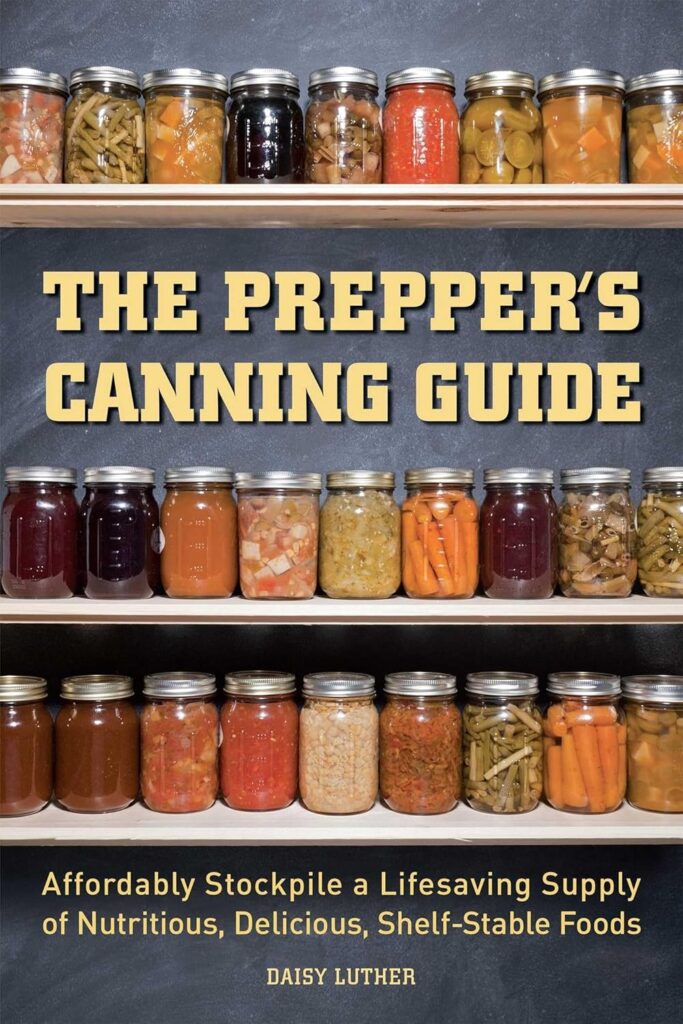
Are you looking to build your emergency food supply on a budget? “The Prepper’s Canning Guide” offers practical tips and recipes for creating nutritious, shelf-stable foods at home. With this comprehensive guide, you can learn how to preserve fruits, vegetables, meats, and more through canning techniques that are affordable and easy to follow. Published on March 14, 2017, this paperback book is a must-have for anyone looking to stockpile essential foods for emergencies. Hey there! Have you ever wanted to be more prepared in case of an emergency or disaster? Well, look no further because “The Prepper’s Canning Guide” is here to help you affordably stockpile a lifesaving supply of nutritious, delicious, shelf-stable foods. Let’s dive in and see how this guide can benefit you and your loved ones.
This image is property of Amazon.com.
Getting Started with Canning
Canning can be a bit intimidating if you’re new to it, but don’t worry, this guide breaks down the process into easy-to-follow steps. You’ll learn all the basics of canning, from selecting the right equipment to choosing the best ingredients for long-lasting food storage.
Equipment Needed
The first step in getting started with canning is making sure you have the right equipment. This guide lists all the essential tools you’ll need, from mason jars to a canner. Don’t worry if you don’t have everything on the list yet – you can start small and gradually build up your canning supplies.
Choosing Ingredients
Once you have your equipment ready, it’s time to choose the ingredients for your canned goods. This guide provides helpful tips on selecting fresh produce, meats, and other foods that are ideal for canning. You’ll learn how to maximize flavor and nutrition while ensuring the long shelf life of your canned goods.
[aiwm-amazon-card title=”The Prepper’s Canning Guide: Affordably Stockpile a Lifesaving Supply of Nutritious, Delicious, Shelf-Stable Foods Paperback – March 14, 2017″ image_url=”https://m.media-amazon.com/images/I/81J3qeVEFOL._SL1500_.jpg” product_url=”https://www.amazon.com/dp/1612436641?tag=gdg0b1-20″ original_price=”” discounted_price=”15.36″ currency=”USD|$” availability=”In Stock” disclaimer=”As an Amazon Associate, I earn from qualifying purchases”]
Canning Techniques
Now that you have your equipment and ingredients ready, it’s time to learn about the different canning techniques. This guide covers both water bath canning and pressure canning methods, so you can feel confident in safely preserving a variety of foods.
Water Bath Canning
Water bath canning is a great technique for preserving high-acid foods like fruits, pickles, and jams. This guide walks you through the process step by step, from preparing your jars to processing them in a boiling water bath. You’ll love how easy it is to create delicious homemade jams and preserves with this method.
Pressure Canning
For low-acid foods like vegetables, meats, and soups, pressure canning is the way to go. This guide teaches you the ins and outs of pressure canning, including how to safely operate a pressure canner and adjust processing times for different types of foods. With pressure canning, you’ll be able to stockpile a wider variety of foods for your emergency pantry.
This image is property of Amazon.com.
Recipes for Every Taste
One of the best parts of “The Prepper’s Canning Guide” is the wide range of delicious recipes it offers. Whether you’re a fan of savory soups, tangy salsas, or sweet jams, you’ll find something to suit your taste buds in this guide. Here are just a few of the mouthwatering recipes you can try:
Pickled Vegetables
If you love the crunch and tang of pickled vegetables, you’ll want to try this easy recipe. Simply pack your favorite veggies into jars with a flavorful brine, process them in a water bath canner, and wait for the magic to happen. You’ll have a delicious and versatile snack or side dish that will last for months in your pantry.
Chicken Noodle Soup
Nothing beats a comforting bowl of chicken noodle soup on a chilly day. With this recipe, you can make a big batch of hearty soup and can it for future enjoyment. Just heat up a jar whenever you’re craving a warm and satisfying meal – it’s like homemade goodness in a flash.
Strawberry-Rhubarb Jam
Sweet and tangy, this strawberry-rhubarb jam is a real treat for your taste buds. Spread it on toast, swirl it into yogurt, or use it as a glaze for meats – the possibilities are endless. You’ll love the burst of fresh fruit flavor in every spoonful of this homemade jam.
Benefits of Canning
Canning your own food offers a host of benefits beyond just emergency preparedness. Here are a few reasons why you’ll love incorporating canning into your lifestyle:
Cost Savings
Buying canned goods from the store can add up quickly, especially if you prefer organic or specialty products. By canning your own food at home, you can save money in the long run and enjoy high-quality foods that you’ve prepared yourself.
Healthier Options
When you can your own food, you have full control over the ingredients that go into your canned goods. You can choose fresh, high-quality produce and avoid synthetic preservatives and additives, creating healthier options for you and your family.
Sustainability
Canning is a great way to reduce food waste and minimize your carbon footprint. By preserving excess produce from your garden or local farmers’ market, you can enjoy seasonal fruits and veggies year-round and support sustainable food practices.
Conclusion
“The Prepper’s Canning Guide” is a must-have resource for anyone looking to build a stockpile of nutritious, delicious, shelf-stable foods. With comprehensive instructions, mouthwatering recipes, and valuable tips, this guide will empower you to take charge of your food supply and be better prepared for whatever comes your way. So go ahead, grab a copy of this guide, roll up your sleeves, and start canning your way to a more secure and self-sufficient future. Happy canning!
Disclosure: As an Amazon Associate, I earn from qualifying purchases.



